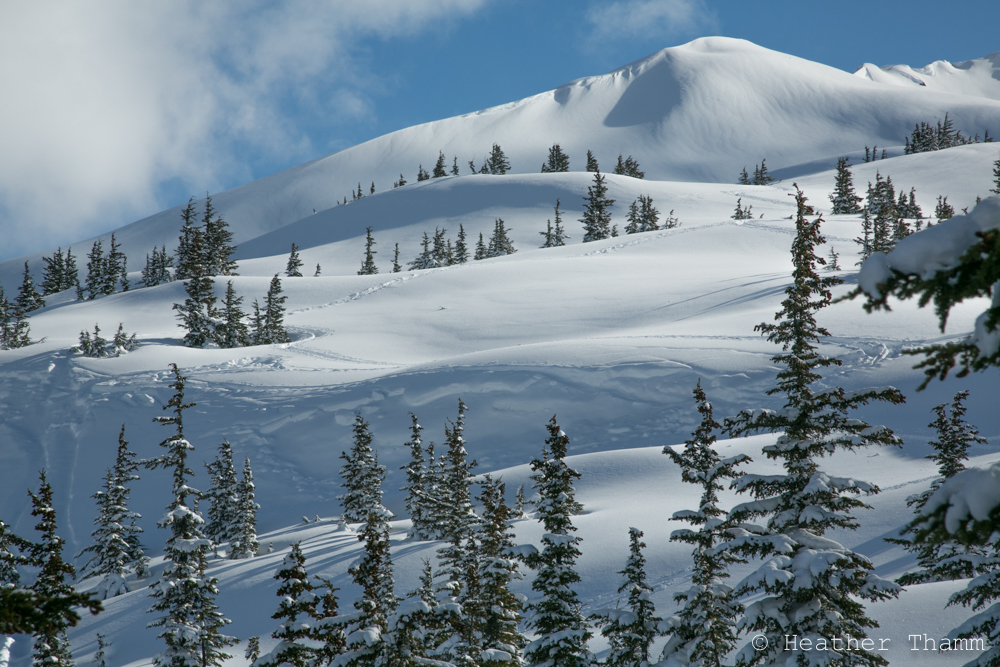| Trigger | remote | Remote Trigger | 0 |
| Avalanche Type | 0 | Aspect | Southwest |
| Elevation | 2500ft | Slope Angle | 38deg |
| Crown Depth | 20in | Width | 200ft |
| Vertical Run | 500ft |
Avalanche: Turnagain
Location: Tincan
Tincan to 2800′
A remote skier triggered slab (D2) was observed on 'CFR' on Tincan. We spoke with a party of three whom claimed to have triggered this slab. The skier said she felt a collapse when it was remotely triggered and said she skied down next to it and blocks were still sliding down. We also spoke with another person who witnessed the event and said a snowboarder remotely triggered it from above. The two stories were a little confusing, and it is possible that both the skier and the snowboarder were in the same area at the same time. Both reporting parties were viewing the event from very different vantage points. The avalanche occurred on a steep slope adjacent to the slope that both the snowboarder and the skier had been on. See photo. There was also another report of a skier triggered slab in the trees at lower elevation, but we did not see where it occurred. The person we spoke with said he triggered it and that it was big enough to bury a person and the crown height was 18" thick.
| Recent Avalanches? | Yes |
| Collapsing (Whumphing)? | Yes |
| Cracking (Shooting cracks)? | Yes |
Throughout the day many natural avalanches D2-D3 was occurring on the East face of Seattle Ridge due to the heat of the sun and air temperature.
We experience widespread collapsing, 10-30 ft in many locations above 2000'.
Cracking was only seen in places where the snow was already disturbed like adjacent to the skin track.
Temps: 30-40F
Wind: Light (5-10mph)
Sky: Mostly sunny
Precip: None
16-25" inches of new snow from 1000 - 2800'
We dug pits in two locations. Slab depths were 20-25". Test results showed greater instability at lower elevations where a weak layer of facets was more intact. In the upper elevations this weak layer was more variable and showed conflicting results in test pits side by side.
2200' -HS≈255cm, SW aspect, Slab was 65cm (25") sitting on a 3-5cm layer of Fist hard facets. Two pits were dug side by side and both had a very similar structure and showed easy to moderate test scores with moderate to high propagation potential. ECTP7(SC) ECTP13(SC) ECTP14(RP)
2800' - Two pits were dug side by side on a SW aspect. Both pits had a HS=255cm.
Pit 1 - Slab depth was 55cm (21") sitting on 4F facets. Results were moderate with high propagation potential. ECTP10 (SC)
Pit 2 - Slab depth was 65cm (25") sitting on Pencil hard layer of old snow (4cm thick) on top of 1F hard facets. This pit showed high strength with no propagation potential. ECTX x 2
*Buried surface hoar (4mm in size) was also found 75cm in pit 1 and 85cm in pit 2 below the surface of the snow. This layer was non-reactive and didn't sheer easily even when pried. It appeared to be laying down and was well bonded to the layers above and below. It was very visible in the pit wall.

Skier remotely triggered slab on the SW aspect of Tincan "CFR". The snowboarder track is the one about 100' away and the skier tracks are just next to it.

The avalanche debris ran about 500'

View looking up from Tincan parking area. Notice how many tracks are on Common Bowl.

View of an old storm slab from the day before, likely from a ski cut. This picture was taken at 12:20pm. Notice that Common Bowl has no tracks yet.

16" of new snow along the road at Turnagain Pass!